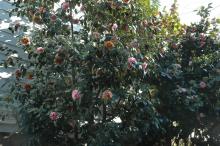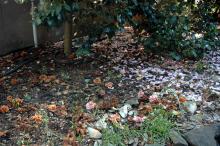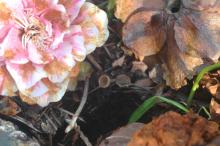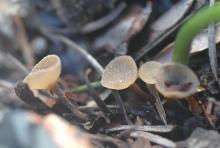Cause Ciborinia camelliae (formerly Sclerotinia camelliae), a fungus that attacks only opened flower parts. Hard brown-to-black fungus bodies (sclerotia) develop in the base of old infected flowers. Sclerotia later produce one or more mushroom-like growths (apothecia), which, in turn, produce spores to cause new petal infections. Sclerotia can survive in soil at least 4 years and serve as a source of apothecia each year. Sclerotia are active during the normal flowering period of camellia. Spores are windblown and can travel up to 1 mile. The disease may spread from flower to flower by direct contact. The disease is common in areas west of the Cascade Range. Quarantined from shipment to Tennessee, and Texas.
Symptoms First, small brown spots on petals. Later, spots enlarge and eventually cover the whole petal. After a few days, the whole flower becomes brown. Spots can be distinguished easily from weather injury, which is usually indicated by lighter colored spots and is limited to the outer margin of camellia flowers. Spots caused by Botrytis are similar.
Cultural control Try several methods over a few seasons.
- Carefully remove and destroy any diseased camellia flowers.
- Rake and destroy old leaves, flowers, and other plant debris, especially under the camellias. Even spent flowers up in the canopy must be removed. Do not put on compost heap unless they are buried.
- Carefully remove the top 3 to 4 inches of soil from beneath plants to eliminate sclerotia in heavily infested soil.
- Fall flowering or early flowering cultivars and species (such as Camellia sasanqua) have been recommended to avoid the main crop of spores in the spring. It is not known how useful this might be in the Pacific Northwest.
Chemical control
- Soil applications to inhibit apothecia. Applications to soil under bushes may not be an effective practice alone because spores still may move to treated bushes from nearby plantings.
- Bonide Captan 50 WP may be used in home gardens at 1 Tbsp/gal water. Washington only. H
- Captan 80 WDG at 0.625 lb/100 gal water. Apply to soil around plants when flowers begin to open; repeat at 7- to 10-day intervals during bloom. Group M4 fungicide. 48-hr reentry.
- Terraclor 400 at 6 to 12 fl oz/100 gal water. Application rate of this solution is based on pot diameter and/or depth of soil, see label for details. Do not use hand application equipment unless in the greenhouse. Begin before buds open; repeat every 3 to 4 weeks during bloom. Group 14 fungicide. 12-hr reentry.
- Ziram 76 DF at 1.5 to 2 lb/100 gal water. Apply as a soil drench. Group M3 fungicide. 48-hr reentry.
- Foliar applications to protect blooms.
- Banner MAXX at 5 to 8 fl oz/100 gal water may be effective. Group 3 fungicide. 12-hr reentry.
- BioAdvanced Disease Control at 0.75 fl oz/gal water. H
- Concert at 22 to 35 fl oz/100 gal water. May cause injury to buds, blooms, or tender new growth. Landscape use only. Group 3 + M5 fungicide. 12-hr reentry.
- Daconil Weather Stik at 1.38 pints/100 gal water. Group M5 fungicide. 12-hr reentry.
- Mancozeb-based products. Group M3 fungicides. 24-hr reentry.
- Fore 80 WP at 1.5 lb/100 gal water plus a spreader-sticker.
- Protect DF at 1 to 2 lb/100 gal water plus 2 to 4 oz spreader-sticker.
- Monsoon Turf at 4 to 10 fl oz/100 gal water. Group 3 fungicide. 12-hr reentry.
- Spectro 90 WDG at 1 to 2 lb/100 gal water. Group 1 + M5 fungicide. 12-hr reentry.
- Tebuzol 3.6F at 4 to 10 fl oz/100 gal water. Group 3 fungicide. No reentry interval listed.
- Torque at 4 to 10 fl oz/100 gal water. Group 3 fungicide. 12-hr reentry.
References Holcomb, G.E. 1990. Camellia flower blight: a summary of nine years of tests with flower protectant fungicides. The American Camellia Yearbook - American Camellia Society. 45:169-173.
Taylor, C.H., and Long P.G. 2000. Review of literature on camellia flower blight caused by Ciborinia camelliae. New Zealand Journal of Crop and Horticultural Science. 28:123-138.






